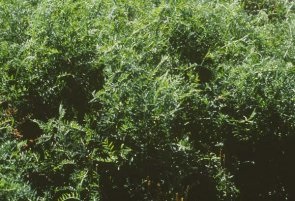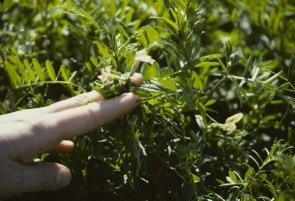Cover crops: hairy vetch
Information on the benefits and growth habits of hairy vetch planted as a cover crop.
Description
Family
- Vicia species
- Winter annual legume
- Many cultivars
Growth habits
Germination
- Vine-like growth habit — 12 to 20" (30–50 cm) in monoculture
- Grows 3 to 4 ft (90-120 cm) in height if sown with cereals — but actual vine length may be much longer
- 9 to 17 pairs of leaflets form leaves, each ending in a tendril
- 20–30 blue-violet flowers are borne on one side of the flower stem
- Stems and leaves are hairy
Top growth
- Seeds are small, round, black and irregularly-sized
- Requires inoculant type "C"
Root system
- Weak tap root (but can grow to 2 to 3 ft (60–90 cm) (in depth)
- Shallow root system — most roots in top 20 cm
- Root growth can continue while plant is dormant
Overwintering
- Overwinters
- Tolerates extremely cold conditions
Site suitability
- Drought tolerant — once established
- Does best on sandy soils
- Does well on most soils if well drained
- Prefers soil pH of 6.0 to 7.0
Control Options
- Close mowing at peak flower can kill hairy vetch — or weaken it sufficiently to help discing finish the task
- If left to grow too long in spring it will deplete moisture in seedbed for following crop
Sensitivity to herbicides
- In corn — combinations of paraquat or glyphosate with: 2,4-D and dicamba all work to control hairy vetch
- Roundup is not effective in killing hairy vetch
Weed control
- One method of controlling volunteer cereals and other annual weeds is to disc or cultivate immediately after the harvest of the previous crop to stimulate seed germination and then till the soil again to kill young weed seedlings just before seeding the cover crop.
- There are no herbicides registered for use on hairy vetch crops.
- Care should be taken not to delay the date of seeding, since a vigorous and competitive cover crop is your best weed control.
- A vigorous crop of hairy vetch usually out competes most annual weeds.
- 2,4-D, MCPA, Banvel or their mixtures should be used
- Note - if hormone sensitive crops are following the cover crop, apply hormone sprays in the fall to avoid injury.
Benefits and cautions
Nutrient management
- Fixes nitrogen
- Can add enough nitrogen to provide almost all of the needs of the subsequent crop
- Can make K more accessible to subsequent crops
Pest management
- Adds to soil biological diversity
- Supports several beneficial insects
- Hosts several species of nematodes
Organic matter
- Due to cold dormancy, it is not suited to early incorporation
- Can add between 2,000 to 5,000 lbs/ac of dry matter
Erosion control
- Once established it provides enough cover to suppress weeds and protect soil
- Provides a longer window of protection than other cover crops
Soil moisture
- Hairy vetch has a moderate rating for water efficiency
- It can rob soil moisture from subsequent crops if left to grow too long in spring
Getting started
Establishment
- 20 to 30 kg/ha
- Seed by mid-August to provide soil cover by winter
- Use stale-seedbed methods to create weed-free growth environment
Cost and availability
- At US $1.25/lb
- Widely available from commercial seed growers
Updated: May 29, 2024
Published: September 16, 2022

